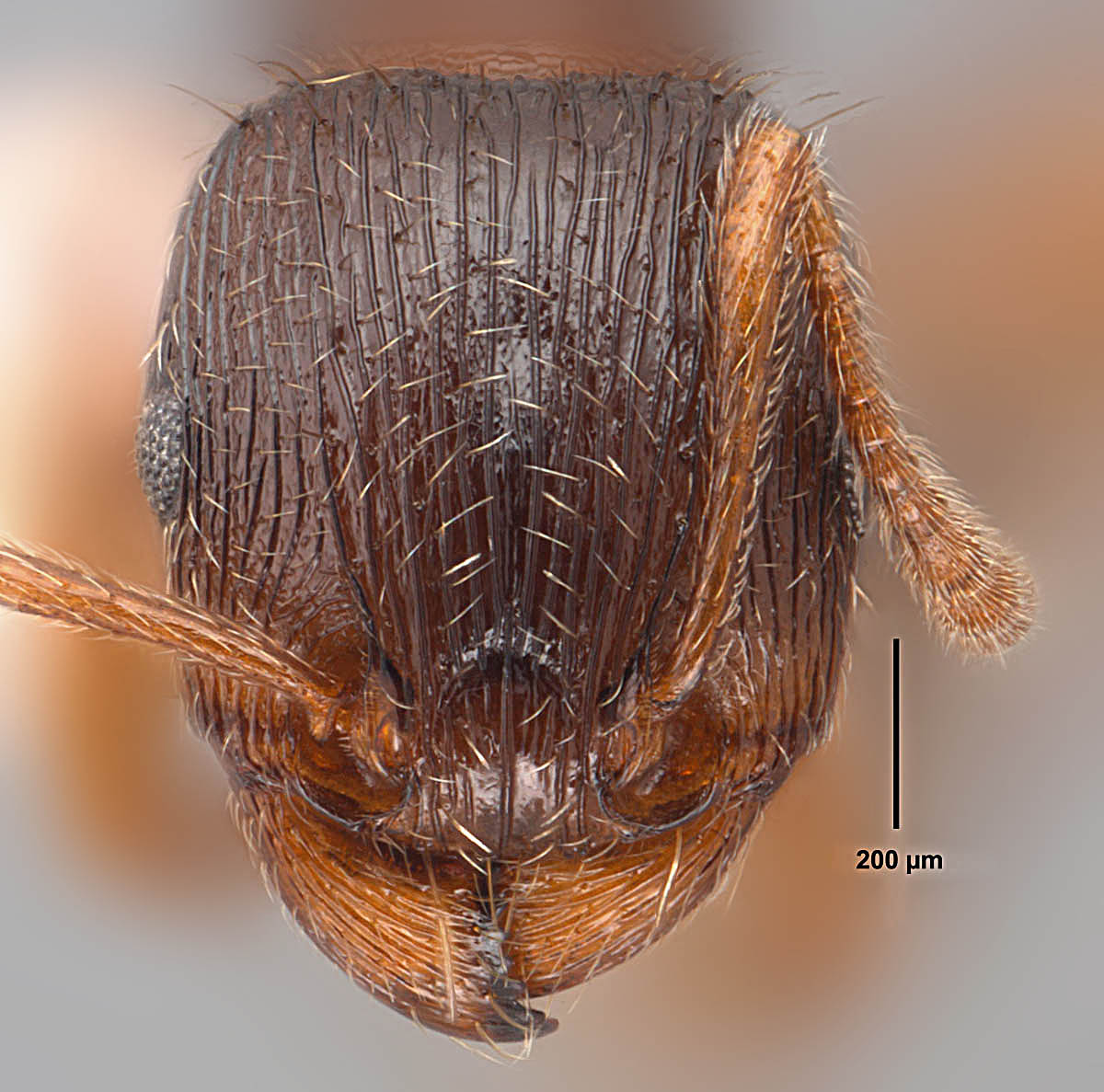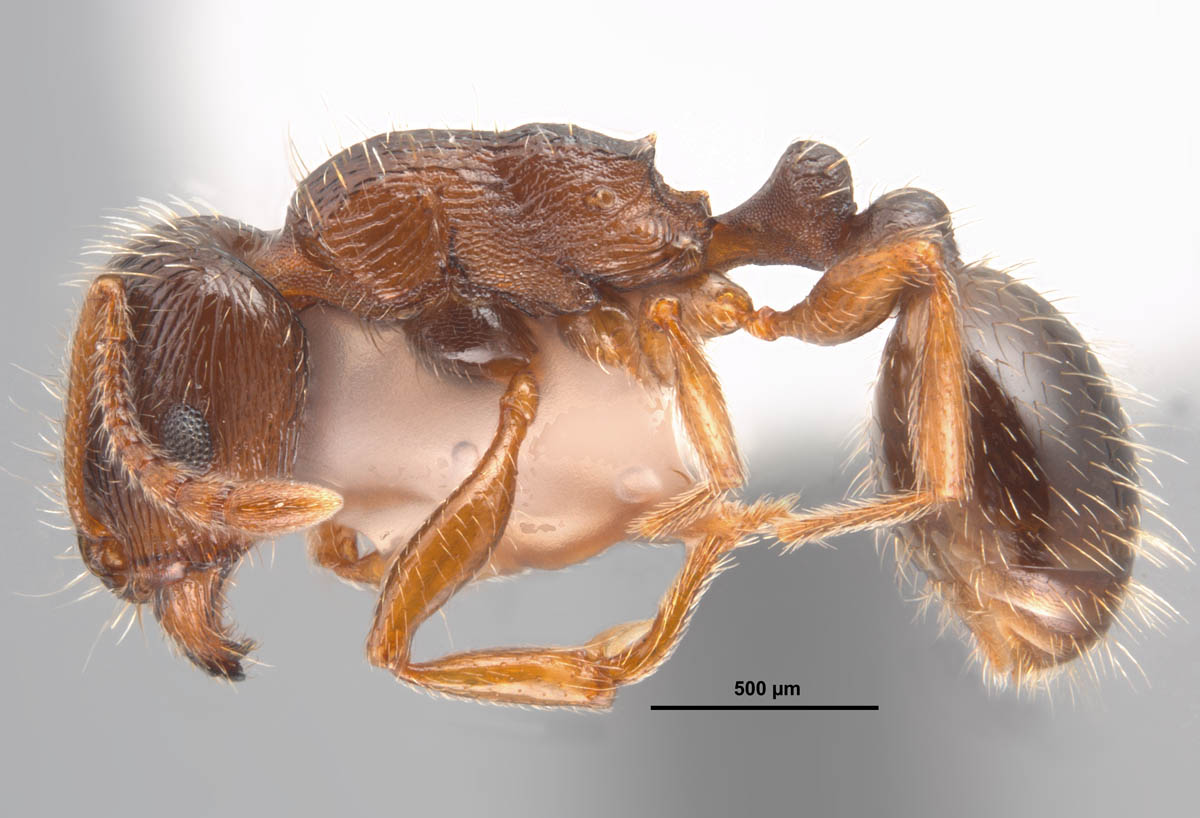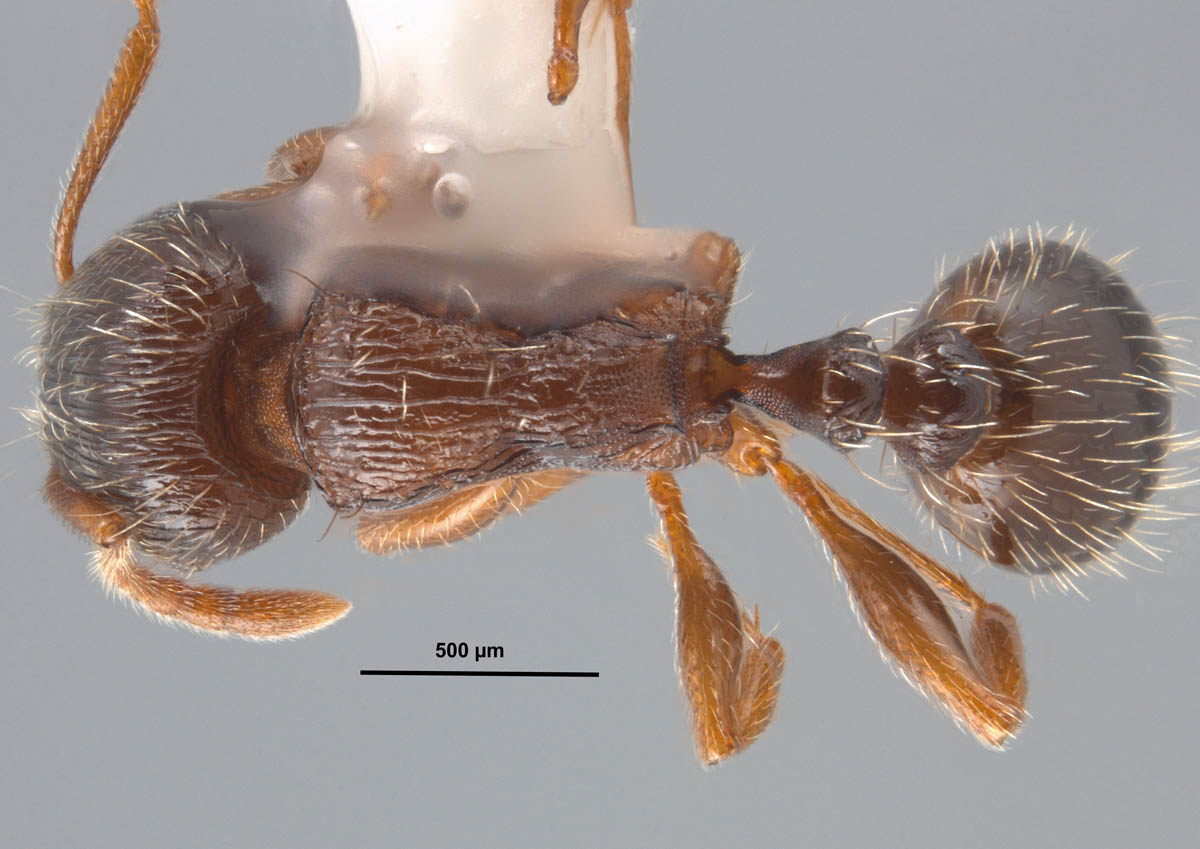Subfamily MYRMICINAE Authors: Joe A. MacGown and Ryan J. Whitehouse |
||
Tetramorium immigrans, full face view of a worker (TN, Sevier Co.) (photo by Ryan Whitehouse and Joe A. MacGown) |
Tetramorium immigrans, lateral view of a worker (TN, Sevier Co.) (photo by Ryan Whitehouse and Joe A. MacGown) |
Tetramorium immigrans, dorsal view of a worker (TN, Sevier Co.) (photo by Ryan Whitehouse and Joe A. MacGown) |
Introduction Tetramorium species can be identified separated from other myrmicine spines but the combination of the following characteristics: lateral part of the clypeus forming a sharp wall anterior to the antennal insertion; frons; 11 or 12-segmented antennae with three-segmented antennal club; antennal scrobe present from antennal insertion point to the posterior corner of head; two segmented waist; sting with a lamellate appendage found apicodorsally that projects at an angle to the long axis of the sting shaft. In most literature, Tetramorium immigrans has been called Tetramorium caespitum (Linnaeus, 1758), or in recent years, Tetramorium sp. E (Schlick-Steiner et al. 2006). In a recent paper on the Tetramorium caespitum complex, Wagner et al. (2017) cleared up confusion about the name by raising the subspecies T. caespitum immigrans Santschi to species level. Tetramorium immigrans is widely distributed across Europe and the United States. They form colonies under stones, litter and other objects on the ground as well as in logs and buildings. In some areas T. immigrans (reported as T. caespitum) is the most common house dwelling ant (Smith 1965). Taxonomic History (Bolton, 2016) Diagnosis Identification Queen: Small, slightly larger than worker (No MEM specimens, based on antwiki.org pictures of one specimen). Overall dark brown, antennae and legs reddish brown. Head about as wide as long, widest posteriorly; with longitudinal rugae from the anterior edge of the clypeus to the posterior margin; entire head with numerous erect, stiff, setae; eyes located laterally at the midline of the head; three small ocelli present; antennae 12-segmented with a three-segmented club; posterior margin of clypeus raised into a sharp ridge anterior to the antennal insertion point; mandibles triangular, with deep longitudinal striae. Mesosoma enlarged, subrectangular in lateral view, dorsum flattened; mesosoma mostly matte except mesoscutum and mesoscutellum, which are slightly shiny; pronotum, anepisternum, posterior region of katepisternum, and sides of propodeum with striae present; mesoscutum with striae limited to posterior region; numerous, erect setae present, especially dorsally; propodeum with a pair of short, blunt tipped spines; propodeal lobes not spine-like. Waist two-segmented, sides and dorsum with transverse striae, with loose reticulation on dorsum of nodes; scattered coarse, setae on dorsal surface; petiolar node triangular in lateral view, with a squarish anterior subpetiolar; postpetiole somewhat elliptical in lateral and dorsal view, more than 1.5 times as wide as petiole in dorsal view. Gaster shining and smooth; first tergite makes up about half of length of gaster; numerous erect setae present on first tergite and sterninte, setae limited to posterior edges of remaining sternites and tergites; sting with a lamellate appendage found apicodorsally that projects at an angle to the long axis of the sting shaft. Male: no MEM specimens. (Based on antwiki.org pictures of one specimen). Color is dark brown to black with antennae and legs lighter in color. Head with hair-like setae on the posterior border and conspicuous setae on the mandibles; eyes large and located laterally along the midline of the head; three ocelli present; antennae are 10-segmented; first funicular segment much shorter than the second; sculpturing is subreticulate. Mesosoma with hair-like setae along the dorsal surface; four wings present; mesonotal segment enlarged; weak longitudinal striations. Waist is two-segmented; sparse, erect setae present; petiole and post petiole nodes relatively low; postpetiolar node about twice the width of the petiolar node. Gaster is smooth and shining with short, hair-like setae located near the posterior border of each tergite; genetalia present at the apex. Biology and Economic Importance Commonly found nesting in and near houses and gardens, Tetramorium immigrans is considered a pest species by some people. They have been known to feed on garden plants and observed to girdle and scar the roots as well as forage upon seeds in seed beds (Smith 1965). Also, in areas where they are prolific, these ants can be the primary house pest, nesting and foraging in homes. Tetramorium caespitum has also been shown to be an intermediate host of the poultry tapeworms Raillietina tetragona (Molin) and R. echinobothrida (Megnin) (Smith 1965). They acquire the cestode parasite by consuming the eggs that were laid on plants. The eggs then will hatch and develop into cysticercoids inside the body cavity of the ant where they wait until the ants gets ingested by a chicken, or other primary host, where they reproduce in the chicken’s gut (Junquera 2007-2016). Because of T. caespitum’s role as an intermediate host for poultry tapeworms, it is important for veterinary science. Tetramorium caespitum has also been known to sting people and has been observed to cause allergic reactions in some people (Smith 1965). Pest Status Distribution Nearctic Region: Canada, United States, and South America (Santschi 1927 and MEM). U.S. Distribution: AL, CA, CO, GA, IL, KY, MA, MD, MS, MO, NE, NM, NJ, NV, OH, OR, PA, NC, NY, SC, TN, UT, VA, WA, WV (antweb.org, antwiki.org and MEM). Acknowledgments Literature Cited Baroni Urbani, C. 1971. Catalogo delle specie di Formicidae d'Italia (Studi sulla mirmecofauna d'Italia X). Memorie della Società Entomologica Italiana 50:5-287. Bolton, B. 1977. The ant tribe Tetramoriini (Hymenoptera: Formicidae). The genus Tetramorium Mayr in the Oriental and Indo-Australian regions, and in Australia. Bulletin of the British Museum (Natural History). Entomology 36:67-151. Bolton, B. 1979. The ant tribe Tetramoriini (Hymenoptera: Formicidae). The genus Tetramorium Mayr in the Malagasy region and in the New World. Bulletin of the British Museum (Natural History). Entomology 38:129-181. Bolton, B. 1980. The ant tribe Tetramoriini (Hymenoptera: Formicidae). The genus Tetramorium Mayr in the Ethiopian zoogeographical region. Bull. Br. Mus. (Nat. Hist.) Entomol. 40: 193-384. Bolton, B. 1995. A new general catalogue of the ants of the world. Cambridge, Mass.: Harvard University Press, 504 pp. Bolton, B. 2016. Bolton World Catalog Ants. Available online: http://www.antweb.org/world.jsp. Accessed 16 May 2016. Bondroit, J. 1918. Les fourmis de France et de Belgique. Annales de la Société Entomologique de France 87:1-174. Brown, W. L., Jr. 1949. Synonymic and other notes on Formicidae (Hymenoptera). Psyche (Cambridge) 56:41-49. Collingwood, C. A. 1979. The Formicidae (Hymenoptera) of Fennoscandia and Denmark. Fauna Entomologica Scandinavica 8:1-174. Curtis, J. 1854. On the genus Myrmica and other indigenous ants. Transactions of the Linnean Society of London 21:211-220. Dalla Torre, K. W. 1893. Catalogus Hymenopterorum hucusque descriptorum systematicus et synonymicus. Vol. 7. Formicidae (Heterogyna). Leipzig: W. Engelmann, 289 pp. Emery, C. 1909. Beiträge zur Monographie der Formiciden des paläarktischen Faunengebietes. (Hym.) Teil IX. Deutsche Entomologische Zeitschrift 1909:695-712. Emery, C. 1925 ("1924"). Notes critiques de myrmécologie. Annales de la Société Entomologique de Belgique 64:177-191. Hauschteck, E. 1961. Die Chromosomen von fünf Ameisenarten. Revue Suisse de Zoologie 68:218-223. Imai, H. T. 1966. The chromosome observation techniques of ants and the chromosomes of Formicinae and Myrmicinae. Acta Hymenopterologica 2:119-131. Junquera, P. 2007-2016. RALLIENTINA SPP, parasitic tapeworms of POULTRY and other BIRDS. Biology, prevention and control. PARASITPEDIA.net/ index.php?option=com_content&view=article&id=2588&Itemid=2870. accessed 18 March 2016. Jurine, L. 1807. Nouvelle méthode de classer les Hyménoptères et les Diptères. Hyménoptères. Vol. 1. Genève: Paschoud, 319 pp. Kupyanskaya, A. N. 1990. Ants of the Far Eastern USSR. [In Russian.]. Vladivostok: Akademiya Nauk SSSR, 258 pp. Kutter, H. 1977. Hymenoptera, Formicidae. Insecta Helvetica. Fauna 6:1-298. Latreille, P. A. 1798. Essai sur l'histoire des fourmis de la France. Brive: F. Bourdeaux, 50 pp. Linnaeus, C. 1758. Systema naturae per regna tria naturae, secundum classes, ordines, genera, species, cum characteribus, differentiis, synonymis, locis. Tomus I. Editio decima, reformata. Holmiae [= Stockholm]: L. Salvii, 824 pp. López, F. 1991a. Variabilidad morfológica y problemas taxonómicos en Tetramorium caespitum (Linné, 1758) y Tetramorium semilaeve André, 1881 (Hym., Formicidae). Boletín de la Asociación Española de Entomologia 15:65-78. Mayr, G. 1861. Die europäischen Formiciden. Nach der analytischen Methode bearbeitet. Wien: C. Gerolds Sohn, 80 pp. Radchenko, A. G.; Czechowski, W.; Czechowska, W. 1998. The genus Tetramorium Mayr (Hymenoptera, Formicidae) in Poland - a survey of species and a key for their identification. Annales Zoologici (Warsaw) 48:107-118. Radchenko, A. G. 2007. The ants (Hymenoptera, Formicidae) in the collection of William Nylander. Fragmenta Faunistica (Warsaw) 50:27-41. Sanetra, M.; Güsten, R.; Schulz, A. 1999. On the taxonomy and distribution of Italian Tetramorium species and their social parasites (Hymenoptera Formicidae). Memorie della Società Entomologica Italiana 77:317-357. Santschi, F. 1927. A propos du Tetramorium caespitum L. Folia Myrmecologica et Termitologica 1:52-58. Schlick-Steiner, B. C., F. M. Steiner, K. Moder, B. Seifert, M. Sanetra, E. Dyreson, C. Stauffer, and E. Christian. 2006. A multidisciplinary approach reveals cryptic diversityin Western Palearctic Tetramorium ants (Hymenoptera:Formicidae). Molecular Phylogenetics and Evolution 40: 259–273. Smith, F. 1851. List of the specimens of British animals in the collection of the British Museum. Part VI. Hymenoptera, Aculeata. London: British Museum, 134 pp. Smith, M. R. 1965. House-infesting ants of the Eastern United States, their recognition, biology, and economic importance. United States Department of Agriculture, Technical Bullitin No. 1326: i-105. Smith, D. R. 1979. Superfamily Formicoidea. Pp. 1323-1467 in: Krombein, K. V.; Hurd, P. D.; Smith, D. R.; Burks, B. D. (eds.) 1979. Catalog of Hymenoptera in America north of Mexico. Volume 2. Apocrita (Aculeata). Washington, D.C.: Smithsonian Institution Press, pp. i-xvi, 1199-2209. Wagner, H. C., W. Arthofer, B. Seifert, C. Muster, F. M. Steiner, and B. C. Schlick-Steiner. 2017. Light at the end of the tunnel: Integrative taxonomy delimits cryptic species in the Tetramorium caespitum complex (Hymenoptera: Formicidae). Myrmecological News 25: 95–129. Wu, J.; Wang, C. 1995. The ants of China. [In Chinese.]. Beijing: China Forestry Publishing House, x + 214 pp. Links |
||





